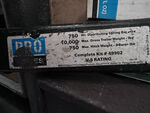Curt MV Weight Distribution System - Round Bar - 8,000 lbs GTW, 800 lbs TW

 Arrives before Christmas
Arrives before Christmas 

- All Info
- Reviews (355)
- Q & A (0)
- Photos
CURT Weight Distribution Hitch - C17051
- 700 lbs
- Fits 2 Inch Hitch
- WD Only
- Requires Disconnection
- CURT
- Includes Shank
- Round Bar
- Top-Mount
- Fits 3 Inch Frame
- Fits 4 Inch Frame
- Fits 5 Inch Frame
- Fits 6 Inch Frame
Restore stability and control in your ride so you can tow to the max capacity of your hitch. Includes round, forged steel spring bars and an adjustable shank. Hitch ball sold separately.
Features:
- Evenly spreads out your tongue weight among all the axles of your tow vehicle and trailer
- Levels out your ride to restore control and stability
- Lets you tow to the max capacity of your hitch
- Built to be easily upgraded for sway control
- Add on an optional bar-style friction sway control kit (17200 - sold separately)
- Desired head tilt is achieved with traditional washer design
- Add or remove washers from spacer rivet to tilt head up or down
- Round spring bars are constructed of solid, forged steel for strength and durability
- Powder coated steel resists corrosion
- Grease zerks in the head assembly make for simple maintenance
- Includes head assembly, adjustable shank, spring bars, lift brackets, lift chains, handle, and all necessary hardware
- Hitch ball with 1-1/4" diameter shank sold separately
Specs:
- Fits: 2" x 2" trailer hitch receivers rated for use with weight distribution systems
- Tongue weight: 600 lbs - 800 lbs
- Maximum gross towing weight: 8,000 lbs
- Lift bracket positioning: 31-3/16" back from hitch ball
- Shank length: 12"
- Maximum rise: 6"
- Maximum drop: 2-1/2"
- 1-Year limited warranty
| Included w/ System | Required - Sold Separately | Optional Add-Ons |
|---|---|---|
|
|
|
Pro Tip: Before you invest in a weight distribution hitch, make sure your cargo is evenly loaded in your trailer to keep the weight balanced. If you still have a hard time even after balancing your tongue weight, a weight distribution hitch should help.
Easy to Upgrade to Active Sway Control

- This system doesn't control sway out of the box - but you can remedy that later on
- You can add a bar-style friction sway control to either side of your trailer (or both sides, if you have a really long trailer)
- Uses friction to force your trailer back in line when it gets pushed off course
- Has to be removed at times (e.g. in the rain or when you're backing up), but its adjustable tension is a plus
- Doesn't work with surge-type actuators
People often conflate sway control with weight distribution. It's understandable because most weight distribution systems on the market today do solve issues with sway.
This system will give you weight distribution only. It doesn't have any sway control built in. If that is something you need right now to keep your trailer from getting squirrelly, take a look at 17200 for a complete MV system. This option allows you to easily dial in the amount of tension with the turn of a handle. This adjustability is nice (even if it takes you a few trips to get it just right), but it doesn't play well with surge-type actuators, and it will have to be removed when backing up and any time you tow on wet or slippery roads.
Adjusting the Head Tilt

- Adding washers adds tension, but it's not a case of "the more the merrier"
- Stacking washers can be a pain, but you only need to do it once, or if your tongue weight changes
To adjust the tilt, simply slide washers onto the spacer rivet and insert it into the head assembly. Once the spacer is in place, tighten the shank bolts to secure the head to the shank. To check if your truck and trailer are level, you'll need to hookup and release your tongue jack. If you find that the rear of your truck is still sagging, add washers to increase leverage. If it looks like too much weight has been taken off your truck's rear axle and is sitting on your front axle, try removing a few washers.
While the washer-stacking method allows you to fine-tune the setup at the time of installation, it's going to require some patience. It can be time consuming because, if you don't get everything right the first time (which, you probably won't), you'll have to take the head unit apart to adjust the washers. You might have to raise or lower the L-brackets too to get the tension just right, and that's a bit of a pain also. Not to mention that you might have to repeat this process if your tongue weight changes or if you swap out your tow vehicle.
Why Use a Weight Distribution Hitch?

- Prevents uneven tire wear on your vehicle and trailer
- Keeps the rear of your tow vehicle from sagging
- Lets you tow to the max capacity of your trailer hitch
- Stops your headlights from pointing up at the sky
- Gives you control over steering your rig
Selecting the Right Weight Distribution System
- Think "Goldilocks"
- If you go for overbuilt, you'll have a rigid ride
- If it's not strong enough, it's virtually useless
- Let your tongue weight be your guide
Your tongue weight is the first thing you need to know when figuring out which weight distribution system you need. Most people think that if they get the highest-rated system possible, it'll be smooth sailing. But actually, this will create a rigid ride and a bouncing trailer. On the other hand, if the system isn't strong enough, it won't be able to distribute the weight properly, making it virtually useless.
Once you know your trailer's tongue weight, add it to the weight of the cargo behind the rear axle of your tow vehicle. Then just choose a weight distribution system rated for that combined tongue weight.
17051 Curt MV Round Bar Weight Distribution Hitch - 800 lbs
Installation DetailsCalifornia residents: click here
Customer Satisfaction Score:
90% were satisfied with this product
10% of customers were not satisfied
- Arrived Damaged
- Product did not meet expectations
- Wrong item was ordered
Ratings & Reviews
4.7
353 reviews
See what our Experts say about this CURT Weight Distribution Hitch
- Can Curt Weight Distribution System Increase Towing Capacity of 2005 Ford F-150Hey Ron, it's pretty common for trucks like your 2005 Ford F-150 to have an increased towing capacity if the truck is using a weight distribution system like the Curt MV part # C17051 that you referenced BUT one of the only ways to know by how much is to check the sticker on the hitch that has the towing capacities listed. You should basically see two sets of towing capacities with one of them being higher if a weight distribution system is being used.
view full answer... - Weight Distribution for 2020 Toyota Highlander Towing Trailer with 360 lb Dry Tongue WeightFor the tongue weight you mentioned of 360 lb dry the Curt weight distribution system # C17052 would be rated too high and would give you a pretty harsh ride quality. The # C17051 with it's range of 600 to 800 lbs would be a much better option once your trailer is loaded and would have a higher tongue weight.
view full answer... - Options for Sway Control Tab for Ball Mount for Attaching Hitch BallSounds like you are looking for the mount for the small ball of your friction sway control unit. You have a couple options like the part # D320 which is a ball mount that has the mounting tab attached to the side of the ball mount platform. We have the # 3442 which allows you to weld a tab onto your current ball mount, or we have the # RP26003 which fits between the ball mount platform and the hitch ball.
view full answer... - Recommended Weight Distribution System for a 4,500 Lb Fleetwood Pop-Up CamperThe Curt Weight Distribution System part # C17341 would be a good choice for your Fleetwood Pop-Up Camper in regards to the weight range capability but I recommend you go with the Curt TruTrack Weight Distribution System part # C17499 instead. The reason for this is because the TruTrack has integrated trailer sway control and prevention as well which will help you maintain your trailer at highway speed in the event of crosswinds or a semi passing. The spring bars are also typically easier...
view full answer... - Weight Distribution For 6,000 lb Trailer With Short A-FrameSo what you'll have to do is use the Chain Hangers # C17005 and bolt them onto your trailer frame. I will also say it's very important you contact the trailer manufacturer to see if the trailer is rated for use with weight distribution because not all aluminum trailers are. Then for a 6,000 lb trailer you would use the Curt MV Weight Distribution # C17051 and instead of using the brackets it comes with you'll use the chain hangers. The only other thing you'll need is the hitch ball, either...
view full answer... - Comparing Blue Ox, Curt, and Fastway Weight Distribution for Starcraft Launch HybridWhen it comes to weight distribution, tongue weight is the most important factor. It looks like you are ahead of the game and accounted for that with each of these systems, great job. I would still recommend finding your actual tongue weight once your trailer is loaded up. You can use a tongue weight scale like the # e99044 or the bathroom scale method to find this. Starting with the Curt # C17051, I would definitely not recommend this over the Blue Ox or Fastway. As you pointed out, this...
view full answer... - Bolt Size of Replacement Bolt Kit for Curt MV Weight Distribution SystemsSure thing - the Replacement Bolt Kit for Curt MV Weight Distribution Systems # C17076 uses 3/4" - 10 x 4 1/2" long hex bolts. According to the linked instructions, they will be tightened to 200 ft lbs. This replacement bolt kit is used to attach the head to the shank. Here are the systems that the Replacement Bolt Kit # C17076 works with: - Curt MV Weight Distribution System - Round Bar - 6,000 lbs GTW, 600 lbs TW # C17050 - Curt MV Weight Distribution System - Round Bar - 8,000 lbs GTW,...
view full answer... - Recommended Sway Control for Towable Ice Fishing HouseThis is a pretty common occurrence for newer 1/2 ton trucks. Due to their customer's demands for a more-car like ride featuring a softer rear suspension, the handling while towing suffers. If you're transporting the ice fishing house on a trailer, you can use a weight distribution system along with a sway control system. If the tongue weight of the trailer is under 800 lbs, I'd go with the Curt # C17051 along with a friction sway control unit like # 17200. If the ice house has its own...
view full answer... - Can the Curt MV 600 LB Weight Distribution System Be UpgradedThe springs bars are the only difference between the Curt MV Weight Distribution Systems part # C17050 and part # C17051 and these are available separately so you can purchase two of the Replacement Spring Bar part # C17072 and then be set when you are towing with your motorcycle in the truck bed. The addition of airbags should not be needed. In regards to installation, the head attachment bolts used to be 1/2" but they are now 3/4" and that is what this is referring to so please disregard...
view full answer... - Can You Back Up with a Curt Weight Distribution System Installed As long as you are backing up mainly in a straight line you can back up with a weight distribution system like the Curt part # C17051 that you referenced. If the angle of the truck and trailer would get more severe than what you would experience while traveling forward you would need to disconnect the spring bars first.
view full answer... - Weight Distribution Recommendation for 6700 lb TrailerA fully loaded trailer weighing 6700 lbs would have a tongue weight that ranges between 600-1000 lbs, so you'd want to choose a system that's rated to cover that possible range. A typical chain-suspended unit like the Curt # C17057 MV weight distribution system would work fine for a utility trailer that's non enclosed, but if it's an enclosed cargo trailer or a travel trailer, you'll really want to do yourself a favor and choose a system with an integrated sway control component. Long...
view full answer... - Curt Weight Distribution with 8,000 lb Trailer Max that Can be Used with Friction Sway ControlThe Curt MV weight distribution part # C17051 has a tongue weight max of 800 lbs and trailer weight max of 8,000 lbs and has tabs on it's head that allow for it to be used with friction sway control like the # 17200.
view full answer... - Is Curt MV Weight Distribution Comparable to Harbor Freight WD SystemThe Curt MV weight distribution part # C17057 would be a great example of a weight distribution similar to the one you found in design and in cost but that is a higher quality. My brother actually has the Harbor Freight WD system and while it has so far not failed I wasn't overly impressed with the build quality. This system is rated for 1,000-1,400 lb tongue weight. For lighter MV models we have the part # C17052 which is rated for 800-1,000, the # C17050 which is rated for 500 lbs...
view full answer... - Solution for Replacement Spring Bars for Valley Industries Weight Distribution HitchI do have a solution, but Valley Industries has gone out of business and replacement parts for your WDH are no longer available. Parts are also not interchangeable between brands. The only option if you're missing the bars is to replace the system entirely. If you want a basic weight distribution system without sway control you can use the Curt MV Weight Distribution System # C17051. However, for just a little bit more you can get the Reese Pro Round Bar Weight Distribution # RE94FR which...
view full answer... - How to Set Up Weight Distribution System on Vehicle with Auto Leveling SuspensionI would recommend you just start over totally with setting up the Curt Weight Distribution System part # C17051 on your trailer and 2009 Chevy Suburban. Like you said you will want to set the trailer on the hitch ball by itself first without the WD system attached to let the auto-level do it's thing. Once settled then you would go about setting up the system. For more information on that check out the install video I attached plus the install instructions link that is attached as well.
view full answer... - Recommended Weight Distribution for 3700 lb Fleetwood Niagara Pop-Up Camper With a weight distribution system, you want to choose a system based on the fully loaded and ready to tow tongue weight of the trailer. I'll link you to a help article that explains how to determine your fully loaded tongue weight, but since you've provided the GVWR (thanks for that, by the way!) we can make a pretty darn accurate educated guess. With a GVWR of 3700 lbs, the tongue weight of your pop-up will range from 370 lbs on the low side to as much as 550 lbs. Both the Curt # C17057...
view full answer... - Installation Instructions for Curt 8000 lb Weight Distribution HitchWe carry a few different weight distribution systems rated for 8,000 lbs manufactured by Curt: -Curt TruTrack Weight Distribution System w/ Sway Control - Trunnion, part # C17499 -Curt MV Weight Distribution System - Round Bar, part # # C17051 -Curt Weight Distribution System with Shank - Pin-Style Trunnion Bar part # C17341 I've included links to their installation instructions at the bottom of the page for you.
view full answer... - Recommended Weight Distribution System for Trailer w/ 630lb Fully Loaded Tongue WeightTo properly choose a weight distribution system, the first step is to determine the fully loaded and ready to tow tongue weight of your trailer. To that figure, add the weight of any gear stowed in the truck bed behind the rear axle. I've linked to an FAQ article that explains how to do this. These combined figures represent the Total Tongue Weight (TTW) of your set-up. The TTW of your trailer should fall as close as possible to the middle of the effective range of the weight distribution...
view full answer... - Weight Distribution Recommendation for Trailer With 3800 lb Dry WeightAs a first step, you really should determine the trailer's tongue weight when it's fully loaded and ready to tow. This would make it much easier to choose the correct system for your needs. I'll link you to a help article that shows a couple of ways to do this, but a tongue weight scale like the etrailer scale # e99044 would be an easy way to figure out your tongue weight. An 8 gallon propane tank weighs about 33 lbs, and a battery around 40 lbs, so you're looking at roughly 100 lbs or...
view full answer... - Should Weight Distribution Bars Flex When InstalledA slight bend in the spring bars of a weight distribution system is normal and just shows that they are doing their job. The bars are made of spring steel which is designed to flex. If they didn't flex the ride quality would be very rough. Since you have an 800 lb tongue weight system you will need to be sure not to exceed this figure with the loaded tongue weight of your setup. I attached a help article on determining tongue weight for you to check out as well.
view full answer... - Are There Any Replacement Spring Bars For The Reese Pro Series 44902 WDS?I went ahead and checked on a replacement for your Reese Pro Series, and it appears that unfortunately the system has been discontinued and it's parts are no longer available for replacement. With that being said, in this situation the best suggestion I can make is for a brand new system. I know that is not what you were hoping to do however if you're interested, I recommend checking out the: -Curt MV Weight Distribution System # C17051. This system is pretty similar to the Pro Series...
view full answer... - Can the Spring Bars On a Reese Pro 49902 Weight Distribution System Be UpgradedIn general, yes, you can replace the spring bars on a weight distribution system. That said, the Reese Pro 49902 is not one we offer replacements for as they have been discontinued by the manufacturer. Furthermore, you cannot use spring bars from a different manufacturer. Therefore, the best option would be to upgrade to a new system for which I recommend the Curt Weight Distribution Kit part # C17051.
view full answer... - Selecting Weight Distribution Hitch for 2015 Toyota Tacoma Towing 2900-lb and 6500-lb TrailerThe key to choosing a weight distribution (WD) system is to know your trailer's actual fully-loaded tongue weight (TW) just as it will be when you head out. To this you need to add the weight of anything in the truck bed that sits behind the rear axle, such as a loaded cooler. Since you noted this is not usually the case with your truck then the actual measured TW of the fully-loaded trailer will give you the information you need. TW matters when choosing a WD system because you want to...
view full answer... - Weight Distribution Hitch Recommendation for Trailer with 755 lb Tongue WeightThe best way to pick out a weight distribution system is to base it off of the loaded tongue weight of the setup when it is loaded and ready to tow. This figure also includes the weight of any cargo behind the rear axle of the tow vehicle. I attached a help article on determining tongue weight for you to check out as well. You will want the loaded tongue weight of your setup to fall right in the middle of the tongue weight range of the system you use. For a loaded tongue weight of 755...
view full answer...
Do you have a question about this Weight Distribution Hitch?
Info for this part was:

















At etrailer.com we provide the best information available about the products we sell. We take the quality of our information seriously so that you can get the right part the first time. Let us know if anything is missing or if you have any questions.


















































Thank you! Your comment has been submitted successfully. You should be able to view your question/comment here within a few days.
Error submitting comment. Please try again momentarily.